List of rulers of Baden
Last updated| Monarchy of Baden | |
|---|---|
Provincial/State | |
 | |
 Frederick II | |
| Details | |
| Style | His Royal Highness (for Grand Dukes) |
| First monarch | Berthold I (as Count) |
| Last monarch | Frederick II (as Grand Duke) |
| Formation | 962 |
| Abolition | 22 November 1918 |
| Appointer | Hereditary |
| Pretender(s) | Bernhard (as Margrave) |
Baden was an Imperial Estate of the Holy Roman Empire and later one of the German states along the frontier with France, primarily consisting of territory along the right bank of the Rhine, opposite Alsace and the Palatinate.
Contents
History
The territory evolved out of the Breisgau, an early medieval county in the Duchy of Swabia. A continuous sequence of counts is known since 962; the counts belong to the House of Zähringen. In 1061, the counts first acquired the additional title of Margrave of Verona. Even though they lost the March of Verona soon thereafter, they kept the title of margrave. In 1112, the title of Margrave of Baden was first used.
For most of the early modern period, the Margraviate of Baden was divided into two parts, one ruled by the Catholic Margraves of Baden-Baden, and the other by the Protestant Margraves of Baden-Durlach. In 1771, the main Baden-Baden line became extinct, and all of the Baden lands came under the rule of the Baden-Durlach line. The reunited margraviate existed until 1803.
During the Napoleonic era, in the imperial reorganisation of 1803, Baden gained a great deal of additional territory, and its ruler was promoted to become one of the few prince-electors of the Holy Roman Empire. However, this situation lasted only for three years until the crushing Battle of Austerlitz at the hands of Napoleon's armies, which caused the Holy Roman Empire to be declared dissolved eight months later, in August 1806.
By definition the Electorate of Baden then ceased to exist as such. Just as the former Holy Roman Emperor now assumed the title of Emperor of Austria, so the ruler of Baden assumed that of Grand Duke of Baden. The Grand Duchy of Baden, with increased additional territory, continued in existence approximately within its 1806 borders until the fall of the German monarchies in 1918, when it became the Republic of Baden.
Counts in Breisgau
- Berthold I, before 962–982
- Berthold II, 982–1005/06
- Berthold III, 1005/06–1024
- Berthold IV, 1024–1073
- Herman I of Baden, 1040–1074
The Margraviate of Baden
During the 11th century, the Duchy of Swabia lacked a powerful central authority and was under the control of various comital dynasties, the strongest of them being the House of Hohenstaufen, the House of Welf, the Habsburgs and the House of Zähringen. Emperor Henry III had promised the ducal throne to the Zähringen scion Berthold, however, upon Henry's death in 1056, his widow Agnes of Poitou appointed Rudolf of Rheinfelden as Duke of Swabia. Berthold renounced his rights and was compensated with the Duchy of Carinthia and the March of Verona in Italy. Not able to establish himself, he finally lost both territories, when he was deposed by King Henry IV of Germany during the Investiture Controversy in 1077. Berthold retired to his Swabian home territory, where he died the next year. The Veronese margravial title was nevertheless retained by his eldest son, Herman I.
Herman II, son of Herman I and grandson of Berthold, had concluded an agreement with the rival Hohenstaufen dynasty, and about 1098 was enfeoffed with immediate territory by Emperor Henry IV. He chose to establish his residence in Germany, as he had been born and raised there. His lordship of choice was Baden (present-day Baden-Baden), where his father had gained the right to rule by marrying the heiress, Judit von Backnang-Sulichgau, Countess of Eberstein-Calw. In Baden, Herman II had Hohenbaden Castle built. Construction began about 1100, and when it was completed in 1112, he marked the occasion by adopting the title of Margrave of Baden.
House of Zähringen
Partitions of Baden under Zähringen rule
| Margraviate of Baden (1161–1515) (Baden-Pforzheim line from 1348) | Baden-Hachberg (1190–1415) | ||||
| Baden-Pforzheim (1290–1348) | Baden-Eberstein (1290–1353) | Baden-Hachberg-Sausenberg (1290–1503) | |||
| (In 1515 new divisions were made) | |||||
| Baden-Sponheim (1515–1533) | Margraviate of Baden-Durlach (Durlach-Sausenberg line from 1604) (1515-1771) | ||||
| Baden-Baden (Baden-Rodemachern line from 1588) (1515–1771) | Baden-Rodemachern (1536–1666) | ||||
| Baden-Durlach-Sausenberg (1577–1604) | Baden-Durlach-Hachberg (1577–1591) | ||||
| Margraviate of Baden (from Baden-Durlach line) (1771–1803) | |||||
Table of rulers
(Note: Between 1190 and 1515 there were three main numberings of rulers in Baden: the Baden numbering, valid for all divisions of Baden with exception of Hachberg; the Hachberg numbering, valid in the namesake territory; and the Hachberg-Sausenberg, division of the previous, which also adopted an independent numbering for its rulers. With the reunion of Baden in 1503, Baden original numbering ended up prevailing over the others.)
| Ruler | Born | Reign | Death | Ruling part | Consort | Notes | |
|---|---|---|---|---|---|---|---|
| Herman II | c.1060 | 1074–1130 | 7 October 1130 | Baden | Judith of Hohenberg c.1105 two children | He was the first to use the title of "Margrave of Baden" (in 1112). | |
| Herman III the Great | c.1105 | 1130–1160 | 16 January 1160 | Baden | Bertha of Lorraine 1134 one child Maria of Bohemia After 1141 one child | In 1151, the margraviate of Verona was taken from Ottokar III of Styria and conferred on Herman III. Took part in the Second Crusade. | |
| Herman IV | c.1135 | 1160–1190 | 13 September 1190 | Baden | Bertha of Tübingen 1162 seven children | Took part in various battles at the side of the German Emperor, and also joined on the Third Crusade. | |
| Henry I | c.1180? | 1190–1231 | 2 July 1231 | Baden-Hachberg | Agnes of Urach Before 1231 three children | ||
| Herman V |  | c.1180 | 1190–1243 | 16 January 1243 | Baden | Irmengard of the Palatinate-Rhine 1217 four children | |
| Henry II |  | Before 1231 | 1231–1289 | 1297 or 1298 | Baden-Hachberg | Anne of Üsingen-Ketzingen Before 1289 eight children | Abdicated in 1289, and joined the Teutonic Knights. |
| Herman VI |  | c.1226 | 1243–1250 | 4 October 1250 | Baden | Gertrude of Austria 1248 two children | Fought in the Austrian War of Succession in 1246, claiming the title "Duke of Austria" from 1248. |
| Frederick I |  | c.1249 | 1250–1268 | 29 October 1268 | Baden | Unmarried | Nephew and uncle (respectively son and brother of Herman VI) ruled jointly. Frederick accompanied King Conradin in his battles and was beheaded with him in 1268. From then on, Rudolph ruled alone. |
| Rudolph I |  | c.1230 | 1250–1288 | 19 November 1288 | Baden | Kunigunde of Eberstein 20 May 1257 eight children | |
| Herman VII the Rouser |  | c.1266 | 1288–1291 | 12 July 1291 | Baden | Agnes of Truhendingen Before 6 October 1278 four children | Children of Rudolph III, ruled jointly. From 1290 the brothers shared land with the sons of Herman VII. |
| Rudolph II the Elder |  | c.1266? | 1288–1295 | 14 February 1295 | Baden | Adelaide of Ochsenstein 2 May 1285 three children | |
| Rudolph III the Younger | c.1266? | 1288–1332 | 2 February 1332 | Baden | Jutta of Strassberg 1306 no children | ||
| Hesso | c.1268 | 1288–1297 | 13 February 1297 | Baden | Clara of Klingen Before 1291 one child? Irmengard of Württemberg Before 1295 no children Adelaide of Rieneck Before 1299 one child | ||
| Henry III |  | Before 1289 | 1289–1330 | 1330 | Baden-Hachberg | Agnes of Hohenberg Before 1310 three children | |
| Rudolph I |  | Before 1289 | 1290–1313 | 1313 | Baden-Hachberg-Sausenberg | Agnes of Rötteln 1298 or 1299 three children | Son of Henry II, founded the Baden-Hachberg-Sausenberg Branch. |
| Frederick II | Before 1278 | 1291–1333 | 22 June 1333 | Baden-Eberstein | Agnes of Weinsberg before 16 October 1312 one child Margaret of Vaihingen Before 1333 four children | Son of Herman VII, founded the Baden-Baden-Eberstein Branch | |
| Herman VIII | Before 1278 | 1291–1300 | 1300 | Baden-Pforzheim | Unmarried | Son of Herman VII, ruled jointly with his brother Rudolph IV. | |
| Rudolph Hesso | c.1290 | 1297–1335 | 17 August 1335 | Baden | Joanna of Burgundy Before 1335 two children | With no male heirs, Baden-Baden was inherited after his death by his cousin, Rudolf IV, Margrave of Baden-Pforzheim. | |
| Rudolph IV | Before 1278 | 1291–1335 | 25 June 1348 | Baden-Pforzheim | Liutgard of Bolanden 28 February 1318 no children Maria of Oettingen 18 February 1326 two children | Ruled Pforzheim with his brother Herman VIII. Rudolph inherited Baden in 1335, after the death of his cousin Rudolph Hesso. | |
| 1335-1348 | Baden | ||||||
| Henry | 1300 | 1313–1318 | 1318 | Baden-Hachberg-Sausenberg | Unmarried | Sons of Rudolph IV, ruled jointly. | |
| Rudolph II | 1301 | 1313–1352 | 1352 | Baden-Hachberg-Sausenberg | Catherine of Thierstein c.1343 two children | ||
| Otto |  | 1302 | 1318–1384 | 1384 | Baden-Hachberg-Sausenberg | Catherine of Grandson no children Elisabeth of Strasbourg Before 1352 no children | |
| Henry IV |  | Before 1310 | 1330–1369 | 1369 | Baden-Hachberg | Anna of Usenberg Before 1369 four children | |
| Herman IX |  | Before 1333 | 1333–1353 | 13 April 1353 | Baden-Eberstein | Matilda of Vaihingen c.3 June 1341 one child | Son of Frederick II, he had a son, who predeceased him. At his death Baden-Baden-Eberstein returned to Baden-Baden. |
| Rudolph V |  | Before 1348 | 1348–1361 | 28 August 1361 | Baden-Pforzheim | Adelaide of Belfort 26 August 1347 no children | After his death without children, Pforzheim returned again to Baden-Baden, to the hands of his nephew Rudolph VI. |
| Frederick III | 1327 | 1348–1353 | 2 September 1353 | Baden | Margaret of Baden-Baden 1345 two children | Sons of Rudolph V, ruled jointly. Frederick married his cousin Margaret, daughter of Rudolph Hesso, and Rudolph IX inherited (after his nrtoher and uncle's death) Pforzheim, reuniting it with Baden-Baden. | |
| Rudolph VI |  | c.1345 | 1353–1372 | 21 March 1372 | Baden | Matilda of Sponheim 1356 three children | Inherited Pforzheim from his uncle, Rudolph V, in 1361, reuniting it with Baden. |
| Otto I | Before 1369 | 1369–1386 | 9 July 1386 | Baden-Hachberg | Unmarried | Died at the Battle of Sempach, against the Swiss. | |
| Bernard I |  | 1364 | 1372–1431 | 5 April 1431 | Baden | Margaret of Hohenberg 1 September 1384 (annulled 1391) no children Anna of Oettingen 27 March 1398 ten children | Sons of Rudolph IX, ruled jointly. In 1415 Bernard annexed the lands of Baden-Hachberg. |
| Rudolph VII |  | After 1356? | 1372–1391 | 1391 | Baden | Unmarried | |
| Rudolph III |  | 1343 | 1384–1428 | 8 February 1428 | Baden-Hachberg-Sausenberg | Adelaide of Lichtenberg 1373 no children Anna of Freiburg 1387 thirteen children | |
| John I | Before 1369 | 1386–1409 | 1409 | Baden-Hachberg | Unmarried | Brothers of Otto I, ruled jointly. | |
| Hesso | Before 1369 | 1386–1410 | 1410 | Baden-Hachberg | Anna of Geroldseck Before 1381 three children Margaret of Tübingen 1381 one child | ||
| Otto II |  | Before 1381 | 1410–1415 | 1418 | Baden-Hachberg | Unmarried | In 1415, possibly in debt, sold Hachberg to his cousin Bernard I of Baden-Baden. |
| William |  | 11 July 1406 | 1428–1441 | 15 August 1482 | Baden-Hachberg-Sausenberg | Elisabeth of Montfort-Bregenz 1425 (annulled 1436) three children | Abdicated in 1441 for his sons. |
| James I |  | 15 March 1407 | 1431–1453 | 13 October 1453 | Baden | Catherine of Lorraine 25 July 1422 seven children | |
| Hugo | After 1427 | 1441–1444 | 1444 | Baden-Hachberg-Sausenberg | Unmarried | Sons of Wiliam I, ruled jointly. In 1458, Rudolph inherited the Swiss county of Neuchâtel. | |
| Rudolph IV |  | 1426 or 1427 | 1441–1487 | 12 April 1487 | Baden-Hachberg-Sausenberg | Margaret of Vienne c.1450 two children | |
| Bernard II |  | 1428 or 1429 | 1453–1458 | 15 July 1458 | Baden | Unmarried | Co-ruled with his brother Charles I. He spent most of his income assisting the poor and those in need. |
| Charles I |  | 1427 | 1453–1475 | 24 February 1475 | Baden | Catherine of Austria 1 July 1447 six children | Co-ruled with his brother until 1458. then ruled alone. |
| Christopher I |  | 13 November 1453 | 1475–1515 | 19 April 1527 | Baden | Ottilie of Katzenelnbogen 30 January 1469 fifteen children | In 1503 annexed Baden-Hachberg-Sausenberg. Ruled an unified Baden, but abdicated for his sons, who divided Baden again. |
| Philip | 1454 | 1487–1503 | 9 September 1503 | Baden-Hachberg-Sausenberg | Maria of Savoy October 1478 one child | Also count of Neuchâtel. Didn't have male heirs and Baden-Hachberg Sausenberg was incorporated in Baden-Baden. However, his possessions in Neuchâtel passed to his daughter Joanna. | |
| Bernard III |  | 7 October 1474 | 1515–1536 | 29 June 1536 | Baden-Baden | Franziska of Luxembourg-Ligny 1535 two children | First margrave of the recreated Baden-Baden. After his death his lands were divided between his sons: Christopher II received Baden-Baden-Rodemachern, and Philibert I, the remaining Baden-Baden. However, as his heirs were minors, the lands remained united under the regency of his widow Franziska. |
| Ernest I |  | 7 October 1482 | 1515–1552 | 6 February 1553 | Baden-Durlach | Elisabeth of Brandenburg-Ansbach-Kulmbach 29 September 1510 seven children Ursula of Rosenfeld 1518 (morganatic) three children Anna Bombast of Hohenheim 1 March 1544 (morganatic) no children | First margrave of Baden-Durlach. Abdicated for his son. |
| Philip I | 6 November 1479 | 1515–1533 | 17 September 1533 | Baden-Sponheim | Elisabeth of the Palatinate 3 January 1503 Heidelberg six children | Received Baden-Sponheim from his father, Christopher I. Died with no surviving sons, and his lands reverted to Baden-Baden. | |
| Regency of Franziska of Luxembourg-Ligny (1536-1554) | Children of Bernard III, ruled under their mother, and then divided the land. | ||||||
| Philibert I |  | 22 January 1536 | 1536–1569 | 3 October 1569 | Baden-Baden | Matilda of Bavaria 17 January 1557 four children | |
| Christopher II |  | 26 February 1537 | 1554–1575 | 2 August 1575 | Baden-Baden-Rodemachern | Cecilia of Sweden 11 November 1564 six children | |
| Bernard IV | 1517 | 1552–1553 | 20 January 1553 | Baden-Durlach | Unmarried | Left no heirs. The land goes to his brother, Charles II. | |
| Charles II |  | 24 July 1529 | 1553–1577 | 23 March 1577 | Baden-Durlach | Kunigunde of Brandenburg-Kulmbach 10 March 1551 two children Anna of the Palatinate-Veldenz 1 August 1558 Heidelberg six children | After his death Baden-Durlach was divided between his three sons: Baden-Durlach-Hachberg went to Jacob III, second son of Charles; Baden-Durlach-Sausenberg to George Frederick, third son of Charles; the remaining Baden-Durlach went to the oldest son, Ernest Frederick. But as the heirs were minors, until 1584 Baden-Durlach remained united under regents. |
| Regency of Albert V, Duke of Bavaria (1569-1577) | The Catholic rite was reintroduced on Baden. Left no descendants. Baden-Baden is inherited by his cousin Edward Fortunatus, of the branch of Baden-Rodemachern. | ||||||
| Philip II |  | 19 February 1559 | 1569–1588 | 7 June 1588 | Baden-Baden | Unmarried | |
| Edward Fortunatus |  | 17 September 1565 | 1575–1588 | 8 June 1600 | Baden-Rodemachern | Maria van Eicken 13 March 1591 Brussels four children | Son of Christopher II, inherited Baden-Baden in 1588 from his cousin Philip III. In the same year he abdicated of Baden-Baden-Rodemachern to his younger brother Philip IV. In 1594 Baden-Baden was occupied by Baden-Durlach. |
| 1588-1594 | Baden-Baden | ||||||
| James III [1] |  | 26 May 1562 | 1584–1590 | 17 August 1590 | Baden-Durlach-Hachberg | Elisabeth of Culemborg-Pallandt 6 September 1584 four children | Second son of Charles II, received Baden-Durlach-Hachberg. |
| Philip IV | 15 August 1567 | 1588–1620 | 6 November 1620 | Baden-Baden-Rodemachern | Maria van Eicken 13 March 1591 Brussels four children | Inherited Baden-Baden-Rodemachern in 1588 from his older brother Edward Fortunatus, who abdicated on him. After his death Rodemachern passed to his nephew and second son of Edward Fortunatus, Herman. | |
| Regency of Ernest Frederick, Margrave of Baden-Durlach (1590-1591) | Posthumous son of James II, died in infancy, under the illegal regency of the margrave of Baden-Durlach, who also annexed Ernest James' margraviate. | ||||||
| Ernest James | 24 August 1590 | 1590–1591 | 29 May 1591 | Baden-Durlach-Hachberg | Unmarried | ||
| Regency of Anna of the Palatinate-Veldenz, Louis III, Duke of Württemberg and Louis VI, Elector Palatine (1577-1584) | Children of Charles II. The oldest son, Ernest Frederick, received the remaining Baden-Durlach. Left no descendants and his lands were inherited by George Frederick, his brother from Baden-Durlach-Sausenberg. Occupied Baden-Baden and passed it to his brother after his death. George Frederick was the third son of Charles II, and received Baden-Durlach-Sausenberg. After the death of his older brothers without heirs, he united in 1604 Baden-Durlach under his rule. Also retained, until 1621, Baden-Baden, but was defeated by his kinsman William II, son of Edward Fortunatus. Reunited, in 1604, Baden-Durlach. | ||||||
| Ernest Frederick |  | 17 October 1560 | 1577–1604 | 14 April 1604 | Baden-Durlach | Anne of East Frisia 21 December 1585 no children | |
| 1594–1604 | Baden-Baden | ||||||
| George Frederick |  | 30 January 1573 | 1577-1604 | 24 September 1638 | Baden-Durlach-Sausenberg | Juliane Ursula of Salm-Neufville 2 July 1592 fifteen children Agatha of Erbach-Breuberg 23 October 1614 three children Elizabeth Stolz 29 July 1621 (morganatic) no children | |
| 1604–1621 | Baden-Baden | ||||||
| 1621–1638 | Baden-Durlach | ||||||
| Herman Fortunatus | 23 January 1595 | 1620–1665 | 4 January 1665 | Baden-Baden-Rodemachern | Antonia Elisabeth of Criechingen 18 April 1627 three children Maria Sidonia of Daun-Falkenstein After 1635 two children | Second son of Edward Fortunatus, inherited from his uncle Baden-Baden-Rodemachern. | |
| William II |  | 30 July 1593 | 1621–1677 | 22 May 1677 | Baden-Baden | Catherine Ursula of Hohenzollern-Hechingen 13 October 1624 fourteen children Maria Magdalena of Oettingen-Baldern 1650 Vienna five children | Oldest son of Edward Fortunatus, recovered his inheritance in 1621. |
| Frederick V the Kinsman [2] |  | 6 July 1594 | 1638–1659 | 8 September 1659 | Baden-Durlach | Barbara of Württemberg 21 December 1616 seven children Eleonore of Solms-Laubach 8 October 1627 three children Maria Elisabeth of Waldeck-Eisenberg 21 January 1634 no children Anna Maria von Hohen-Geroldseck 13 February 1644 no children Eusebia Elisabeth of Fürstenberg 20 May 1650 no children | |
| Frederick VI the Turkish |  | 16 November 1617 | 1659–1677 | 31 January 1677 | Baden-Durlach | Christina Magdalena of the Palatinate-Zweibrücken-Kleeburg 30 November 1642 Stockholm eight children Johanna Bayer of Sendau After 1662 (morganatic) two children | |
| Charles William | 1627 | 1665–1666 | 1666 | Baden-Baden-Rodemachern | Unmarried | Died without descendants and his lands reverted to Baden-Baden. | |
| Louis William the Turkish |  | 8 April 1655 | 1677–1707 | 4 January 1707 | Baden-Baden | Sibylle of Saxe-Lauenburg 27 March 1690 Ostrov ten children | Grandson of William I. Made war with France. |
| Frederick VII Magnus |  | 23 September 1647 | 1677–1709 | 25 June 1709 | Baden-Durlach | Augusta Marie of Holstein-Gottorp 15 May 1670 Husum eleven children | |
| Regency of Sibylle of Saxe-Lauenburg (1707-1727) | Sibylle has been credited with the reconstruction of Baden-Baden, which had been ravaged greatly by the French during various wars. | ||||||
| Louis George the Hunter (under regency of Sibylle of Saxe-Lauenburg (1707-1727)) |  | 7 June 1702 | 1707–1761 | 22 October 1761 | Baden-Baden | Maria Anna of Schwarzenberg 8 April 1721 Český Krumlov four children Maria Anna Josepha of Bavaria 20 July 1755 Ettlingen no children | |
| Charles III William |  | 27 January 1679 | 1709–1738 | 12 May 1738 | Baden-Durlach | Magdalena Wilhelmine of Württemberg 27 June 1697 (separated 1715) three children | |
| August George |  | 14 January 1706 | 1761–1771 | 21 October 1771 | Baden-Baden | Maria Victoria of Arenberg 7 December 1735 Rastatt no children | Last male member of the Baden-Baden line, after his death without heirs Baden-Baden fell to the Baden-Durlach line, who reunited all Baden. |
| Regencies of Magdalena Wilhelmine of Württemberg (1738-1742) and Charles August of Baden-Durlach (1738-1746) | In 1746 attained majority. In 1771 inherited the Baden-Baden lands and reunified the margraviate of Baden.In 1803 became Elector. | ||||||
| Charles Frederick |  | 22 November 1728 | 1738–1771 | 10 June 1811 | Baden-Durlach | Caroline Louise of Hesse-Darmstadt 28 January 1751 five children Louise Caroline of Hochberg 24 November 1787 (morganatic) five children | |
| 1771–1803 | Baden | ||||||
Elector of Baden, 1803–1806
| Elector of Baden | ||||
|---|---|---|---|---|
| Baden Dynasty | ||||
| Image | Name (Birth–Death) | Began | Ended | Notes |
 | Charles Frederick Karl Friedrich (1728–1811) | 27 April 1803 | 25 July 1806 | The first and only Elector of Baden. Became Grand Duke of Baden. |
Grand Dukes of Baden, 1806–1918
| Grand Dukes of Baden [3] [ better source needed ] | ||||
|---|---|---|---|---|
| Baden Dynasty | ||||
| Image | Name (Birth–Death) | Began | Ended | Notes |
 | Charles Frederick Karl Friedrich (1728–1811) | 25 July 1806 | 10 June 1811 | |
 | Charles I Karl I (1786–1818) | 10 June 1811 | 8 December 1818 | Grandson of Charles Frederick. |
 | Louis I Ludwig I (1763–1830) | 8 December 1818 | 30 March 1830 | Uncle of Charles. |
 | Leopold I Leopold I (1790–1852) | 30 March 1830 | 24 April 1852 | Half-brother of Louis I. |
 | Louis II Ludwig II (1824–1858) | 24 April 1852 | 22 January 1858 | Son of Leopold I. Ruled under the regency of his brother Frederick. |
 | Frederick I Friedrich I (1826–1907) | 22 January 1858 | 28 September 1907 | Brother of Louis II. Served as regent 1852–1858. Took the title of Grand Duke in 1856. Became a subordinate ruler in the German Empire after the Unification of Germany in 1871. |
 | Frederick II Friedrich II (1857–1928) | 28 September 1907 | 22 November 1918 | Son of Frederick I. The last Grand Duke of Baden. Abdicated in the German Revolution of 1918–1919. |
Presidents of the Republic of Baden, 1918–1945
See also
Related Research Articles

The Duchy of Carinthia was a duchy located in southern Austria and parts of northern Slovenia. It was separated from the Duchy of Bavaria in 976, and was the first newly created Imperial State after the original German stem duchies.

The House of Zähringen was a dynasty of Swabian nobility. The family's name derived from Zähringen Castle near Freiburg im Breisgau. The Zähringer in the 12th century used the title of Duke of Zähringen, in compensation for having conceded the title of Duke of Swabia to the Staufer in 1098. The Zähringer were granted the special title of Rector of Burgundy in 1127, and they continued to use both titles until the extinction of the ducal line in 1218.

The history of Baden-Württemberg covers the area included in the historical state of Baden, the former Prussian Hohenzollern, and Württemberg, part of the region of Swabia since the 9th century.
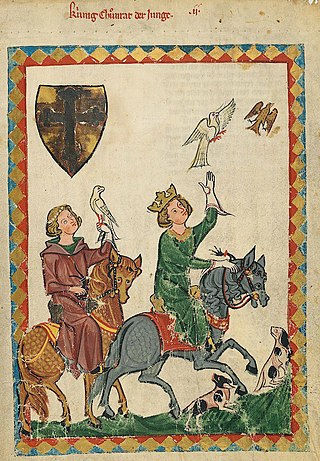
Frederick I of Baden, a member of the House of Zähringen, was Margrave of Baden and of Verona, as well as claimant Duke of Austria from 1250 until his death. As a fellow campaigner of the Hohenstaufen king Conradin, he likewise was beheaded at the behest of King Charles I of Naples.
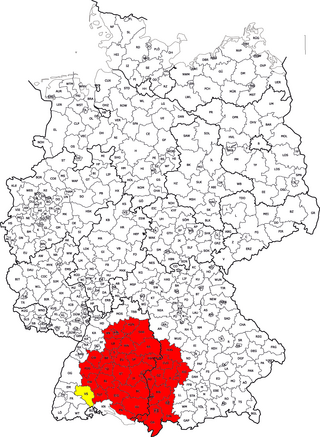
Swabia is a cultural, historic and linguistic region in southwestern Germany. The name is ultimately derived from the medieval Duchy of Swabia, one of the German stem duchies, representing the territory of Alemannia, whose inhabitants interchangeably were called Alemanni or Suebi.
The Dukes of Swabia were the rulers of the Duchy of Swabia during the Middle Ages. Swabia was one of the five stem duchies of the medieval German kingdom, and its dukes were thus among the most powerful magnates of Germany. The most notable family to rule Swabia was the Hohenstaufen family, who held it, with a brief interruption, from 1079 until 1268. For much of this period, the Hohenstaufen were also Holy Roman Emperors. With the death of Conradin, the last Hohenstaufen duke, the duchy itself disintegrated, although King Rudolf I attempted to revive it for his Habsburg family in the late-13th century.
Frederick I before 21 July was Duke of Swabia from 1079 to his death, the first ruler from the House of Hohenstaufen (Staufer).
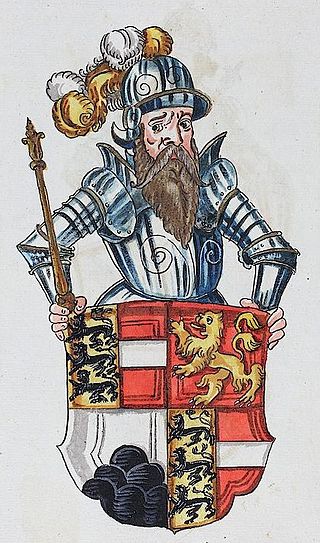
Berthold II, Duke of Carinthia, also known as Berthold I of Zähringen, was a progenitor of the Swabian House of Zähringen. From 1061 until 1077, he was the Duke of Carinthia and Margrave of Verona.

The Margraviate of Baden was a historical territory of the Holy Roman Empire. Spread along the east side of the Upper Rhine River in southwestern Germany, it was named a margraviate in 1112 and existed until 1535, when it was split into the two margraviates of Baden-Durlach and Baden-Baden. The two parts were reunited in 1771 under Margrave Charles Frederick, even if the three parts of the State maintained their distinct seats to the Reichstag. The restored Margraviate of Baden was elevated to the status of electorate in 1803. In 1806, the Electorate of Baden, receiving territorial additions, became the Grand Duchy of Baden. The rulers of Baden, known as the House of Baden, were a cadet line of the Swabian House of Zähringen.

The Duchy of Swabia was one of the five stem duchies of the medieval German Kingdom. It arose in the 10th century in the southwestern area that had been settled by Alemanni tribes in Late Antiquity.

The Duchy of Austria was a medieval principality of the Holy Roman Empire, established in 1156 by the Privilegium Minus, when the Margraviate of Austria (Ostarrîchi) was detached from Bavaria and elevated to a duchy in its own right. After the ruling dukes of the House of Babenberg became extinct in male line, there was as much as three decades of rivalry on inheritance and rulership, until the German king Rudolf I took over the dominion as the first monarch of the Habsburg dynasty in 1276. Thereafter, Austria became the patrimony and ancestral homeland of the dynasty and the nucleus of the Habsburg monarchy. In 1453, the archducal title of the Austrian rulers, invented by Duke Rudolf IV in the forged Privilegium Maius of 1359, was officially acknowledged by the Habsburg emperor Frederick III.

Berthold IV, a member of the House of Andechs, was Margrave of Istria and Carniola. By about 1180/82 he assumed the title of Duke of Merania, referring to the Adriatic seacoast of Kvarner which his ancestors had conquered in the 1060s and annexed to Istria and Carniola.

The Marchof Carniola was a southeastern state of the Holy Roman Empire in the High Middle Ages, the predecessor of the Duchy of Carniola. It corresponded roughly to the central Carniolan region of present-day Slovenia. At the time of its creation, the march served as a frontier defense against the Kingdoms of Hungary and Croatia.

The March of Verona and Aquileia was a vast march of the Holy Roman Empire in the northeastern Italian peninsula during the Middle Ages, centered on the cities of Verona and Aquileia. Seized by King Otto I of Germany in 952, it was held by the Dukes of Bavaria; from 976 in personal union with the Duchy of Carinthia. The margravial regime ended with the advent of the Lombard League in 1167.
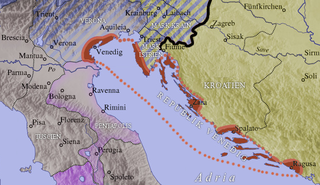
The March of Istria was originally a Carolingian frontier march covering the Istrian peninsula and surrounding territory conquered by Charlemagne's son Pepin of Italy in 789. After 1364, it was the name of the Istrian province of the Habsburg monarchy, the Austrian Empire and Austria-Hungary.

The coat of arms of Baden comes from the personal arms of the Margraves and Grand Dukes of Baden, the traditional rulers of the region. Following the revolution and abolition of the Grand Duchy in 1918, the arms and griffin supporters were usurped from the Grand Dukes by the new republic to represent the people and country.

The Margraviate of Baden-Durlach was an early modern territory of the Holy Roman Empire, in the upper Rhine valley, which existed from 1535 to 1771. It was formed when the Margraviate of Baden was split between the sons of Margrave Christopher I and was named for its capital, Durlach. The other half of the territory became the Margraviate of Baden-Baden, located between the two halves of Baden-Durlach. Baden-Durlach became Lutheran during the Protestant Reformation, unlike Baden-Baden, which remained Catholic. Baden-Durlach occupied Baden-Baden from 1594 to 1622, but was driven out after being defeated at the Battle of Wimpfen, during the Thirty Years' War (1618-1648). The territory was ravaged during the Nine Years' War (1688-1697). Following the extinction of the Baden-Baden line in 1771, the Baden-Durlach inherited their territories and reunited the Margraviate of Baden. The reunified territory was caught up in the French Revolutionary and Napoleonic Wars, emerging in 1806 as the Grand Duchy of Baden.
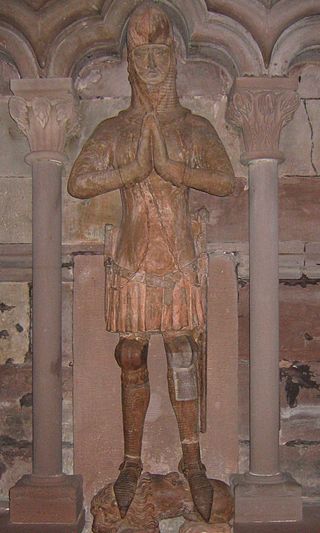
The Counts of Freiburg were the descendants of Count Egino of Urach. They ruled over the city of Freiburg and the Breisgau between approximately 1245 and 1368.

The Margraviate of Baden-Hachberg was a territory of the Holy Roman Empire, in the upper Rhine valley, which existed from 1212 to 1415.
References
- ↑ He is numbered III after Jakob von Baden (Archbishop of Trier), usually counted as James II but didn't rule.
- ↑ He is numbered V after Frederick of Baden (Bishop of Utrecht), usually counted as Frederick IV but didn't rule.
- ↑ Marek, Miroslav. "baden/baden4.html". genealogy.euweb.cz.[ self-published source ]
Text is available under the CC BY-SA 4.0 license; additional terms may apply.
Images, videos and audio are available under their respective licenses.